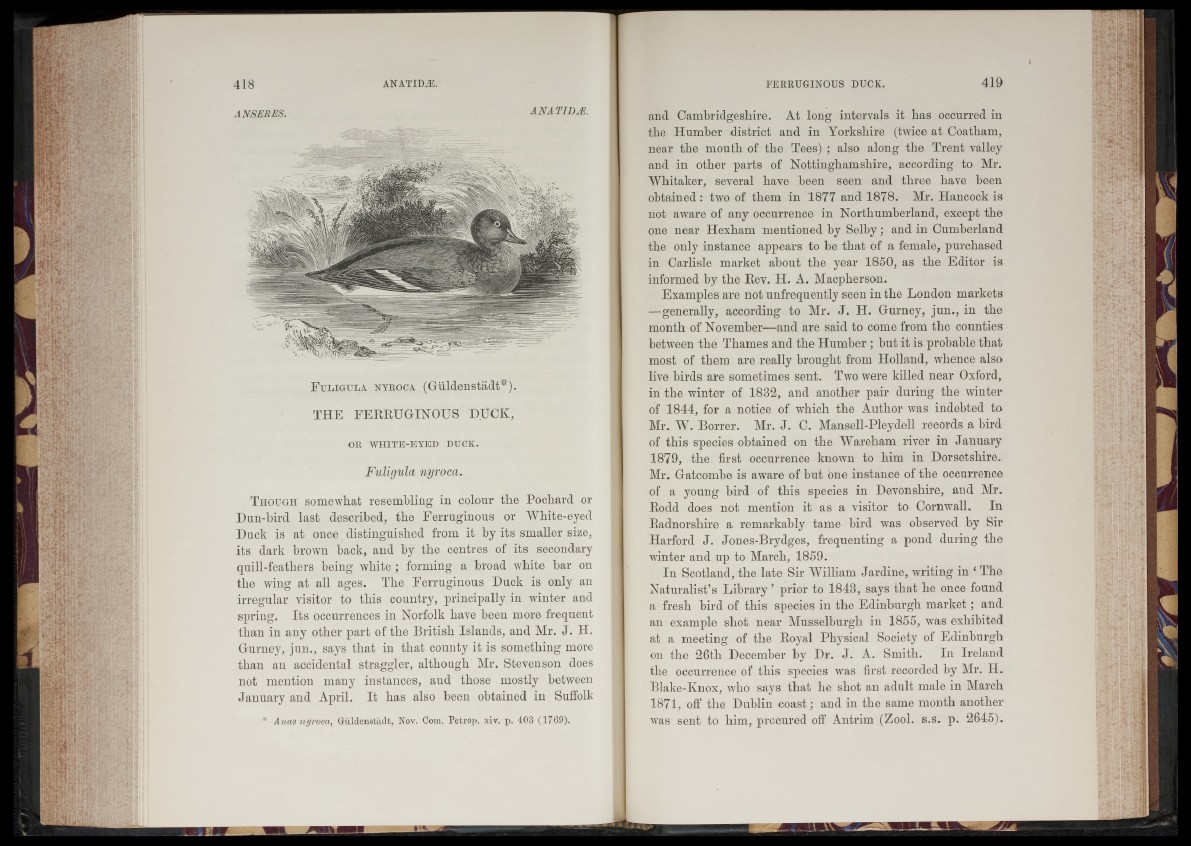
ANSERES. ANA TIDAL
F u l ig u l a nyroca (Güldenstädt*).
THE FERRUGINOUS DUCK,
OR WHITE-EYED DUCK.
Fuligula nyroca.
T h o ug h somewhat resembling in colour the Pochard or
Dun-bird last described, the Ferruginous or White-eyed
Duck is at once distinguished from it by its smaller size,
its dark brown back, and by the centres of its secondary
quill-feathers being white ; forming a broad white bar on
the wing at all ages. The Ferruginous Duck is only an
irregular visitor to this country, principally in winter and
spring. Its occurrences in Norfolk have been more frequent
than in any other part of the British Islands, and Mr. J. H.
Gurney, jun., says that in that county it is something more
than an accidental straggler, although Mr. Stevenson does
not mention many instances, and those mostly between
January and April. It has also been obtained in Suffolk
* Anas nyroca, Giildenstiidt, Nov. Com. Petrop. xiv. p. 403 (1769).
and Cambridgeshire. At long intervals it has occurred in
the Humber district and in Yorkshire (twice at Coatliam,
near the mouth of the Tees) ; also along the Trent valley
and in other parts of Nottinghamshire, according to Mr.
Whitaker, several have been seen and three have been
obtained: two of them in 1877 and 1878. Mr. Hancock is
not aware of any occurrence in Northumberland, except the
one near Hexham mentioned by Selby; and in Cumberland
the only instance appears to he that of a female, purchased
in Carlisle market about the year 1850, as the Editor is
informed by the Rev. H. A. Macpherson.
Examples are not unfrequently seen in the London markets
—generally, according to Mr. J. H. Gurney, jun., in the
month of November—and are said to come from the counties
between the Thames and the Humber ; but it is probable that
most of them are really brought from Holland, whence also
live birds are sometimes sent. Two were killed near Oxford,
in the winter of 1832, and another pair during the winter
of 1844, for a notice of which the Author was indebted to
Mr. W. Borrer. Mr. J. C. Mansell-Pleydell records a bird
of this species obtained on the Wareliam river in January
1879, the first occurrence known to him in Dorsetshire.
Mr. Gatcombe is aware of but one instance of the occurrence
of a young bird of this species in Devonshire, and Mr.
Rodd does not mention it as a visitor to Cornwall. In
Radnorshire a remarkably tame bird was observed by Sir
Harford J. Jones-Brydges, frequenting a pond during the
winter and up to March, 1859.
In Scotland, the late Sir William Jar dine, writing in ‘ The
Naturalist’s Library ’ prior to 1843, says that he once found
a fresh bird of this species in the Edinburgh market; and
an example shot near Musselburgh in 1855, was exhibited
at a meeting of the Royal Physical Society of Edinburgh
on the 26tli December by Dr. J. A. Smith. In Ireland
the occurrence of this species was first recorded by Mr. H.
Blake-Knox, who says that he shot an adult male in March
1871, off the Dublin coast; and in the same month another
was sent to him, procured off Antrim (Zool. s.s. p. 2645).